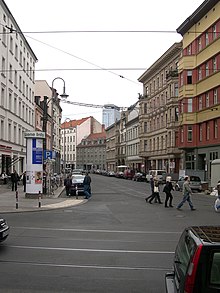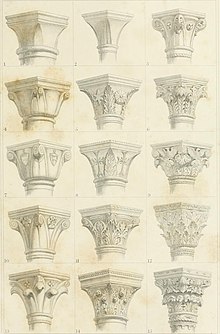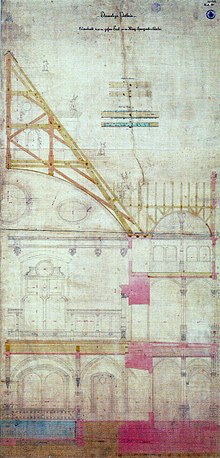Architectural history
The history of architecture is that part of cultural studies or the humanities that deals primarily with the humanities and, secondarily, with engineering and sociological methodology with the historical dimension of architecture .
Research items
Architectural history explores the history of architecture, i.e. buildings , their media ( architectural drawings , models ), architectural theory and the discourse on architecture, as well as urban planning and settlement history . Even if the history of urban development is a separate branch of the history of architecture, an architectural history can get along but never without the urban dimension.
interest
Since every time, every country and every region has its own form of architecture, the history of architecture wants to get on the track of this phenomenon. It determines the personal, local and temporal factors that play a role in the construction of a building or, at a higher level, in the character of a period or epoch. The aim is to understand the cultural and historical significance of architecture within the social context.
In the 19th century, the history of architecture established itself both as part of the academic subjects of art history and archeology and as a subject of architectural training. This multi-part genesis also gives rise to different definitions and focus areas that can be understood as part of various specialist discourses. So z. For example, within art history and archeology, the history of architecture is understood as a genre-related focus analogous to genres of fine art such as painting, drawing or sculpture. For a long time, the history of art and archeology was dominated by a methodology based on the history of style, which pursued the formulation and humanistic interpretation of so-called epoch styles as an essential goal. For the modern era, work complexes by important architects such as B. Andrea Palladio reconstructed and researched. The iconography is concerned with the analysis of the image programs of buildings in the context of their installation location and its construction-related shaping such. B. in figure portals of medieval churches.
History has also dealt intensively with the historical aspects of architecture such as the history of ownership, functions and political significance of the buildings.
The most recent epochs were often excluded as objects of research. Since the 1980s, the idea of objectifying all epochs, including those of modernity and post-war modernism , and not of discriminating against one of them by denying its historicity , has prevailed, first within the preservation of monuments and soon beyond .
methodology
Just as architecture, in its everyday practice and social perception, is in a mediator role between art and function, the history of architecture also uses methods from art history as well as history, technology, the history of technology and sociology . In concrete terms, no building can be fully understood without the design aspect, for example the design of the structure, the combination of materials, etc., the functions and the meanings, together with the technical aspect.
The technical aspects include structural engineering, material production, availability, and properties. The construction techniques, in particular, are a key distinguishing feature of the various times, as they are always related to the specific design of the structures. This view is a modern one, but it can also be found in Vitruvius in antiquity or Andrea Palladio . A systematic analysis of the functional and meaningful aspects of the buildings was only integrated into the history of architecture at a late stage, as it was necessary to go beyond the older approaches of design and technical analysis and an interdisciplinary approach to the historical sciences and newer subjects such as sociology and semiotics .
The architectural historian's working method can therefore be described as follows:
Often the history of architecture is based either on a concrete structural analysis without directly affecting the historical context, or on a reconstruction of larger historical contexts such as B. the change in style, of functional requirements or intended references to other buildings. It is not entirely clear whether a distinction can be made here in German between building history and architectural history. In any case, the history of architecture tends towards a multi-pronged approach and, due to its humanities and its claim to the development of historical syntheses ("history of architecture"), is not limited to a focus on a single building.
For the individual analysis, which is more closely linked to the term building history and historical building research, this means that you first document, describe and assess how material, construction, function, space, decoration, color, etc. are dealt with in the building. A graphic or photographic documentation is made or older building photographs are used. Linguistic descriptions are developed. Various analytical methods are used to differentiate between relative construction phases and to work out an absolute dating . For the reconstruction of major historical developments, the extensive research literature and the overview representations must be evaluated as thoroughly as possible and critically assessed.
The second step, which sometimes takes place beforehand, is the search for image and written sources and other statements about the individual building, e.g. B. in archives, libraries and building authorities, questioning contemporary witnesses and residents. Reading relevant publications is also part of this. Finally, the environment in which the building is located must be analyzed.
The results of the two steps are put into a local, personal and historical context: the relationship between the client's intention and his or her social position, etc., as well as the architect's personality and, finally, the relationships in which materials and techniques are used. In this way, the building can ultimately be understood in terms of the references that led to its specific characteristics. The synopsis of many such individual analyzes leads to an understanding of the references in which a period or epoch of architectural history and its specific characteristics stands.
The discourse on methodology and delimitation
Architectural history corresponds to a social task. However, both experts and representatives of various academic disciplines have expressed different views on the content and methodology.
One background of the dispute is the dispute as to whether architecture is a (visual) art or an engineering achievement , which was mainly conducted in the field of architectural education and contemporary architectural theory. Historically, this division arose in the course of the early modern period; she was previously unknown. The assignment to (construction) art or engineering leads to the fact that the history of architecture is either viewed as part of art history or as a subject of the history of technology or specifically the more recent subject of the history of construction technology. Dealing with the research object is therefore determined by the specifications of individual specialist traditions and cannot be logically resolved. In 2005, at one of the introductory speeches at the Art Historians' Day, the opinion typical of art history was expressed that the history of architecture should not be named as a separate subject. This is where the notion typical of older art history came into play, namely that architectural history could be limited to the investigation of artistic aspects. There is a position among architects that the history of architecture is not a separate subject, but part of architectural theory. The Cologne church builder Rudolf Schwarz , for example, took the view in 1953 that architects should not allow themselves to be “put to bed with superfluous humanities” with the history of architecture. Schwarz believed that architects themselves should research the history of architecture and did not want to delve into an academic humanities. The diversity of such positions illustrates the different weighting that is assigned to individual methods and questions and can be understood as the materialization of different paradigms or ways of thinking.
The position that architectural history is an independent subject with a complex methodical repertoire stands out from these integrating views. In this sense, architectural history endeavors to take into account technical, artistic, cultural-historical and biographical aspects in order to arrive at an adequate understanding of the cultural phenomenon of architecture and to write its own history of architecture. Evidence of such a view are z. B. the existence of own professorships, own museums and topic-related journals and an own professional community.
history
The Roman architect Vitruvius with his book “De architectura libri decem” or the Renaissance literary figures Alberti and Palladio could already be described as architectural historians, although the difference to the modern architectural history of the 19th and 20th centuries is striking: the older theorists of the Renaissance have seen their works mainly in terms of a collection of patterns that they interpret in order to base their own architectural theory on them. Vitruvius' treatise, on the other hand, is not a sample book and the only surviving textbook on the history of architecture from antiquity, and many copies were preserved in the Middle Ages. The architect and military engineer referred to the teachings of the "ancients", by which not only the Greeks were meant. For Vitruvius, the so-called “syngraphai” and “praecepta” - building descriptions and sample designs - by the Greek architects were the most important source for his “novel textbook” (Vitruv 1.praef.2). He dedicated the "Ten Books on Architecture" to Emperor Augustus and addressed potential clients as well as architects and contractors. With the advent of the printing press, Vitruvian design theory - it was based on a basic dimension / modulus - found widespread use in often misunderstood interpretations in Europe since the Renaissance.
In any case, the beginnings of research into the history of architecture lie in the interest of the Italian Renaissance architects in ancient architecture, especially in the city of Rome, which they drew, measured and analyzed in order to obtain models for their own works. In the 18th century, European educational travelers visited the art venues of Italy as part of their Grand Tour and described the architectural masterpieces there, focusing primarily on ancient and modern times as exemplary style epochs.
In the context of the rediscovery of ancient architecture (such as Pompeii in the 1750s, or Troy around 1830), ancient architecture became tangible beyond the previous canon . Occasionally, however, the great cathedrals of the Middle Ages north of the Alps came into view, which are admired as objects of local or national history and as technical masterpieces. In France, England and Germany the “Gothic” style was seen as a national achievement. After antiquity was replaced as the only norm of art with the end of classicism, the search for historical models for contemporary art led to a more intensive preoccupation with architecture of all times and peoples. In the course of the blossoming of historical studies and academic art history in the 19th century, style categories (cf. Stilkunde ) were developed for the analysis of the history of architecture. The delimitation of the style epochs from one another only develops over time. “Gothic” and “Romanesque” are terms from architectural history that have spread throughout the history of style. Research into national art monuments began, parallel to the beginnings of monument preservation . The restoration work of the architects (e.g. Viollet-le-Duc ) on the medieval cathedrals resulted in a lot of knowledge about the building history. Local and regional historical research by historical societies (England with its Archaeological Societies is a pioneer, in France the Societés Archéologiques follow this example) are available alongside the first overview presentations (e.g. Franz Kugler , History of Architecture. Stuttgart 1856–1859). Teaching at the architecture schools was increasingly historically oriented. In the course of the 19th century people turned more and more to neglected and ignored epochs such as the baroque. The research interest was always related to the aesthetic prejudices of the present. The urban planning tasks of the Wilhelminian era aroused interest in the city's history and historical urban planning . Even modernity and the following currents never place themselves outside the reception of historical building concepts, despite the radical stylistic innovations.
Modern architectural history explores architecture as a cultural phenomenon in its historical dimension for the general public. It goes beyond a purely historical representation or professional historical building and monument research and is also used in interdisciplinary approaches such as urban studies , spatial planning and landscape planning by showing the historical and cultural nature of individual designs and positions. She has also long since recorded and researched the building activity of all cultures from a global perspective.
History of architecture as a subject
As a rule, architectural history is not studied as a separate subject, but instead a combination of subjects that serve to understand the particular way in which architectural history works, such as art history, architecture, and monument preservation. Even classical archeology is often used as a study of architectural historians.
application areas

A person who conducts architectural history professionally and with a critical awareness of methods is called an architectural historian. Architectural history has a wide variety of applications, but four of them are the most common: architecture, monument preservation , architectural museums and city tours.
Architects use architectural history to find suggestions for current projects, to compare the coping with similar problems or to coordinate a structure with its surroundings, i.e. i.e., either fitting it in or taking it off. In the case of the deliberately chosen adaptation, it is ultimately a case of cityscape maintenance or monument preservation.
In the preservation of historical monuments, research into the history of architecture aims initially at an assessment of the buildings in an area in order to determine which have such a high cultural and historical value that they have to be registered as historical monuments with scientific justification ( inventory phase ). The architectural-historical research of registered monuments serves to protect them. On the one hand, building research must evaluate a building in its parts (as previously in the inventory phase as a whole) in order to decide which ones are unconditional, which are conditional and which are not worth protecting at all (phase of monitoring a building measure). On the other hand, the publications on the history of architecture serve the preservation of monuments to publicize the monuments. These publications contribute to their protection by means of persuasion.
In architectural museums and archives, the architectural heritage - mostly of a region - is collected and processed in the form of plan materials, archives or models and made available to the general public in exhibitions.
In the field of tourism and city tours, the architectural history of a city or an area is the most haunting means of explaining its character and identity.
literature
in order of appearance
History of science
- Klaus Jan Philipp: Single file of styles. Sketches for the history of architectural historiography . Stuttgart 1998.
Overall representations
- David Watkin: The rise of architectural history. Architectural, London 1980.
-
WBG architectural history . Scientific Book Society (WBG), Darmstadt 2013–2015.
- Vol. 1: Christoph Brachmann: The Middle Ages, 800–1500. Monasteries - cathedrals - castles . 2014, ISBN 978-3-534-23984-9 .
- Vol. 2: Meinrad von Engelberg: Die Neuzeit, 1450-1800. Order - Invention - Representation . 2013, ISBN 978-3-534-23985-6 .
- Vol. 3: Christian Freilang : Die Moderne, 1800 to today. Architecture - Technology - Society . 2015, ISBN 978-3-534-23986-3 .
- Pavlos Lefas: Architecture. A Historical Perspective . Jovis Verlag, Berlin 2014, ISBN 978-3-86859-315-0 .
Individual epochs and geographical areas
- Robert Suckale : Art in Germany. From Charlemagne to today . DuMont, Cologne 1998.
- Hans Ibelings: European architecture since 1890 . Jovis Verlag, Berlin 2011, ISBN 978-3-86859-038-8 .
Individual points of view
- Richard Strobel, Felicitas book: Ortanalyse. For recording and evaluating historical areas (= workbooks of the Baden-Württemberg State Monuments Office ). Theiss, Stuttgart 1986.
- Michael Petzet , Gert Mader : Practical monument preservation . Kohlhammer, Stuttgart, Berlin and Cologne 1993.
- Norbert Huse: Inconvenient architectural monuments . CH Beck, Munich 1997 (This book develops a differentiated picture of various aspects of architectural history inspired by the preservation of monuments.)
- Ralf Liptau: Forming architectures. The model in post-war modern design processes. transcript, Bielefeld 2019, ISBN 978-3-8376-4440-1 .
Web links
Individual evidence
-
^ Norbert Huse: Inconvenient architectural monuments. CH Beck, Munich 1997.
Roman Hillmann: Anti-Modernism and Architectural Rhetoric: The Case of Prince Charles. (pdf, 1.6 MB) In: Edinburgh Architectural Research, 29. 2004, pp. 67–71 , accessed on October 16, 2018 (English). - ↑ Michael Petzet, Gert Mader: Practical monument preservation. Kohlhammer, Stuttgart / Berlin / Cologne, 1993.
- ^ Richard Strobel, Felicitas Buch: Ortanalyse. For recording and evaluating historical areas (= workbooks of the Baden-Württemberg State Monuments Office). Theiss, Stuttgart 1986.
- ^ Roman Hillmann: III. International Congress on Construction History (Third International Congress on the History of Structural Engineering) at the Brandenburg University of Technology Cottbus from May 20 to 24, 2009, organized by the Chair for the History of Structural Engineering and Structural Maintenance. (pdf, 366 kB) In: Kunsttexte.de 3/2009. September 10, 2009, accessed October 16, 2018 (review).
- ^ Rudolf Schwarz: Make artists, don't talk. In: Baukunst und Werkform 6 (1953), issue 1, pp. 9-17.
- ↑ Compare for example Robert Suckale: Art in Germany. From Charlemagne to today. Monte von DuMont, Cologne 1998, there pp. 416-421.
- ↑ Landesdenkmalamt Berlin (Ed.): Monument topography Federal Republic of Germany. Monuments in Berlin. Mitte district. Mitte district, Michael Imhof, Berlin and Petersberg 2003, pp. 447–451.

